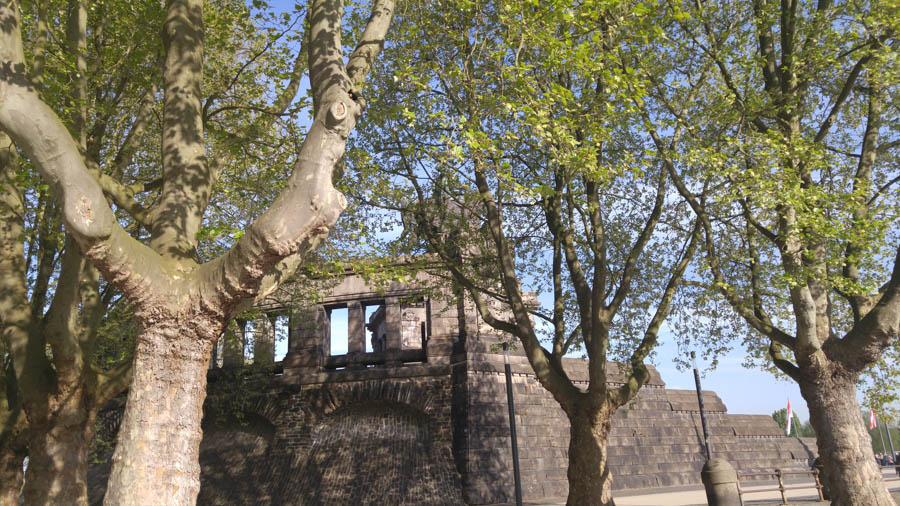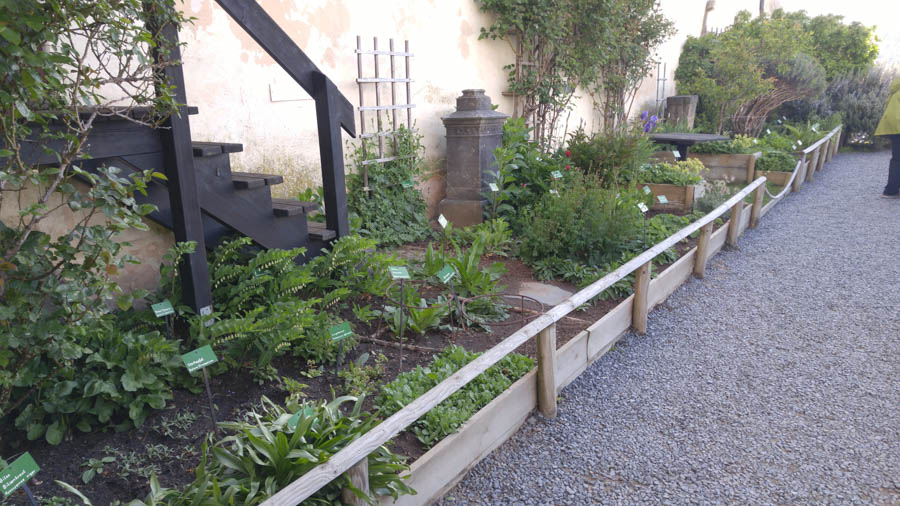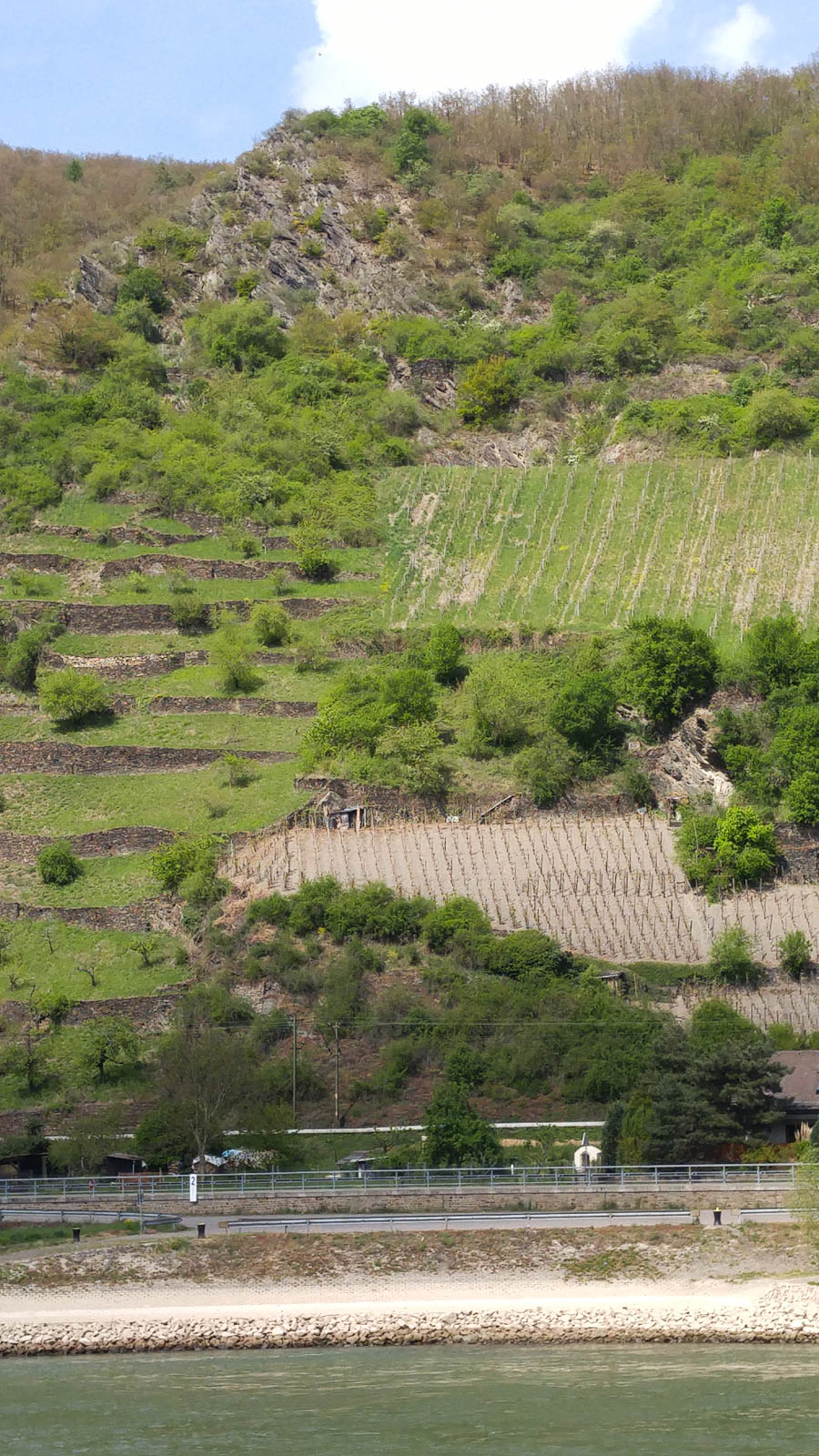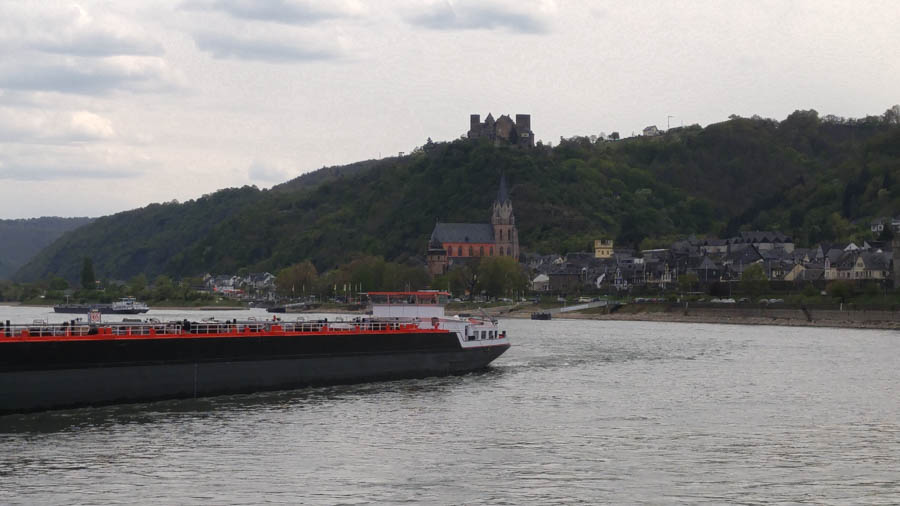Day #4 - Koblenz, Germany (Page Nine)



We departed Cologne about midnight and headed 70 miles to the south ending up at Koblenz and then sailed the afternoon seeing the castles along the Rhine.
Did You Know? - Koblenz is an ancient city in central Germany, and a gateway to the terraced vineyards and ruined castles of the Rhine Gorge. In the center, a monumental statue of William the Great marks the confluence of the Rhine and Moselle rivers. A cable car connects to the hilltop Ehrenbreitstein Fortress, which hosts museums and cultural events. South along the river is the neo-Gothic Stolzenfels Castle with its gardens.

We tied up right near the center of the city. Easy walking to the local sights.

We will visit the fortress a little later

Lots of historical ruins as the city is 2,000 years old!

We walked to the Deutsches Eck where
the
Rhine (left) and Mosel rivers meet

William I, first German Emperor
Did You Know? - Deutsches Eck ("German Corner") is the name of a headland in Koblenz, Germany, where the Mosel river joins the Rhine. Named after a local commandry of the Teutonic Order (Deutscher Orden), it became known for a monumental equestrian statue of William I, first German Emperor, erected in 1897 in appreciation of his merits in the unification of Germany. One of many Emperor William monuments raised in the Prussian Rhine Province, it was destroyed in World War II and only the plinth was preserved as a memorial. Following German reunification, a replica of the statue was erected on the pedestal after controversial discussions in 1993. It is today a Koblenz landmark and a popular tourist destination.

We walked out to the point to see the rivers join forces

Wonderful view of the rivers

The ramps provide for ease of lowering boat into the river


Almost hidden in the trees

Short walk
Did You Know? - The Basilica of St. Castor (German: Basilika St. Kastor or Kastorkirche) is the oldest church in Koblenz in the German state of Rhineland Palatinate. It is located near Deutsches Eck at the confluence of the Rhine and the Moselle. A fountain called Kastorbrunnen ("Castor well") was built in front of the basilica during Napoleon’s invasion of Russia in 1812. Pope John Paul II raised St. Castor to a basilica minor on 30 July 1991. This church is worth seeing for the historical events that have occurred in it, its extensive Romanesque construction and its largely traditional furnishings.

1100+ years old!
Did You Know? - The church of St. Castor was built between 817 and 836 by Hetto, the Archbishop of Trier with the support of Emperor Louis the Pious, just outside the city of Confluentes (the city founded by the Romans in the area) and dedicated on 12 November 836.

Magnificent vaulted ceilings
Did You Know? - From 1496 to 1499, vaulting was installed to replace the Romanesque roof. At the same time, two star vaults were erected in the nave and above the altar.

Did You Know? - Between 1840 and 1860, the interior was provided with frescoes. The final appearance of St. Castor’s was restored between 1890 and 1894, when the entire church was provided with a veneer of tuff.

The WWII damage has been repaired
Did You Know? - On 6 November 1944 St. Castor’s was damaged by a British air raid. In March 1945 the outer walls were also damaged by artillery. The stone material including the vault, however, remained largely intact. In 1948 enough money was raised for its reconstruction and a 25-year renovation began. Extensive renovation and restoration work was carried out on the towers in 1979 to 1990.

We continue strolling through town

Narrow streets everywhere

Love the outdoor restaurants

We must visit the fortress!

Did You Know? - Ehrenbreitstein Fortress (German: Festung Ehrenbreitstein) is a fortress on the mountain of the same name on the east bank of the Rhine opposite the town of Koblenz in the German state of Rhineland-Palatinate.
Occupying the position of an earlier fortress destroyed by the French in 1801, it was built as the backbone of the regional fortification system, Festung Koblenz, by Prussia between 1817 and 1828 and guarded the middle Rhine region, an area that had been invaded by French troops repeatedly before. The Prussian fortress was never attacked
 350 feet above the Rhine has a
commanding view of the area
350 feet above the Rhine has a
commanding view of the area
Did You Know? - The fortress is open to visitors. It is connected to the town of Koblenz across the Rhine by a cable car and by an inclined lift to the foot of the hill. Ehrenbreitstein houses several museums: Haus der Fotografie (photography), Haus der Archäologie (archaeology) and the Landesmuseum Koblenz (temporary exhibitions).

We can see for miles

Well fortefied
Did You Know? - During World War II, the fortress served as a place of safekeeping for archives and cultural objects (1943–56) but also harbored three flak guns (1943–45)

The rooms were rather large

Mother nature finds a way

Flower popping out all over

Did we say view?

No, these are NOT the flak guns...

NO one is going to go down the river if the fortress says no!

There is even a garden in the fortress

Well maintained

Here comes another long boat

One had to make wine in the fortress

You do need instruction!
Did You Know? - After World War II, it was used first by the French Army before it was handed over to the State of Rhineland-Palatinate in 1947. In 1946-50 it served as a refugee camp and then, in the period of insufficient housing in the early 1950s, as residential housing (into the 1960s). In 1952, a youth hostel was opened, followed by a museum in 1956.

Squish thoe grapes

Cooking for many

They would hang up the days hunting results for the cook to use

The stone sink would last forever

Little beds for little people

Many small rooms has unique purposes

The music room

Roped off to keep people fom using the privy... Long way down!

Chain mail and iron suit of the day

Does not look too comfortable!

The ol' smithy was always in need

Looking south to our next destination

Goodbye... See you later


Back on board.... Away we go!

Indeed a fortress!

We see it go by as we have a leasurely lunch

The river is pretty busy

The convent is in the center of town
Did You Know? - The city of Hirzenach looks back on a 1000 year's history. The view of the city is dominated by one of the oldest convents of the central Rhineland, the former Benedictine provost. It consists of the provost church and the accompanying provost building, gardens which are preserved in Baroque style and a former parish church, now used as residential house.

...and the cameras go wild!

Castles are all along the river in this area

Reisling grapes being grown on the side of the hills

Most of the ship contain cargo... Some are fairly large

Sankt Goar, Burg Rheinfels
Did You Know? - Burg Rheinfels (monumental zone) – one of the biggest castle ruins on the Rhine, noteworthy both for the castle-building technique of the Counts of Katzenelnbogen in the 14th century and for the palatial and fortification building work done in the 16th and 18th centuries by the Landgraves of Hesse-Kassel
Founded in 1245 by Count Diether of Katzenelnbogen on the site of an older valley castle; in the 13th and 14th centuries expanded into a residence for the Lower County, in the 14th and 15th centuries a midpoint on the Rhine; 1567-1583 residence of Landgrave Philip II of Hesse-Rheinfels; from 1796 demolished by explosives in stages and used as a stone quarry

Sitting on the deck... A delightful way to travel

The Convent is hundreds of years old

Did You Know? - Sankt Goar is a town on the west bank of the Middle Rhine in the Rhein-Hunsrück-Kreis (district) in Rhineland-Palatinate, Germany. It belongs to the Verbandsgemeinde of Sankt Goar-Oberwesel, whose seat is in the town of Oberwesel.
Sankt Goar is well known for its central location in the Rhine Gorge, a UNESCO World Heritage Site since July 2002. Above the town stand the ruins of Burg Rheinfels, one of the castles for which the Middle Rhine is famous, and across the river lies the sister town of Sankt Goarshausen with its own castles, Katz and Maus (“Cat” and “Mouse”). The famous Lorelei rock is close-by, slightly upstream on the opposite bank.

Hanging out on the side of a mountain!

Up close and personal with the local towns

Marks the rock mountain
Did You Know? - The Lorelei (German: Loreley) is a 132 m (433 ft) high, steep slate rock on the right bank of the River Rhine in the Rhine Gorge (or Middle Rhine) at Sankt Goarshausen in Germany.

Watch out Captain... You're getting a little close!

Small city dating back 500 years

It was a walled city at one time

Tight corner...

The tower is called "The Ox Tower" becaus eit was so strong

The Church of Our Lady

We keep moving and won't stop until this evening

The Pfalzgrafenstein Castle
Did You Know? - The keep of this island castle, a pentagonal tower with its point upstream, was erected 1326 to 1327 by King Ludwig the Bavarian. Around the tower, a defensive hexagonal wall was built between 1338 to 1340. In 1477 Pfalzgrafenstein was passed as deposit to the Count of Katzenelnbogen. Later additions were made in 1607 and 1755, consisting of corner turrets, the gun bastion pointing upstream, and the characteristic baroque tower cap.
The castle functioned as a toll-collecting station that was not to be ignored. It worked in concert with Gutenfels Castle and the fortified town of Kaub on the right side of the river. Due to a dangerous cataract on the river's left, about a kilometer upstream, every vessel would have to use the fairway nearer to the right bank, thus floating downstream between the mighty fortress on the vessel's left and the town and castle on its right. A chain across the river drawn between those two fortifications forced ships to submit, and uncooperative traders could be kept in the dungeon until a ransom was delivered. The dungeon was a wooden float in the well.
Unlike the vast majority of Rhine castles, "the Pfalz" was never conquered or destroyed, withstanding not only wars, but also the natural onslaughts of ice and floods by the river. Its Spartan quarters held about twenty men.

Quite amazing!

Grapes and more grapes

Advertising?
Did You Know? - Site and soil: Apart from Berg Schlossberg, this vineyard is said to be the best site in the Rüdesheimer Berg area. The name is derived from the Middle High German word "rotten", which points to the clearing ("Rodung") of the area in the 11th century. The sheltered location very close to the River Rhine and deep layers of the predominant loess loam soil interspersed with quartzite, shale and gravel produce wines that boast fruitiness, minerality and a delicate acidity.

We float down the river enjoying a wonderful meal!

Peaceful

The Bierbicht Palace slides right by us!
Did You Know? - Biebrich Palace (German: Schloss Biebrich) is a Baroque residence (Schloss) in the borough of Biebrich in the city of Wiesbaden, Hesse, Germany. Built in 1702 by Prince Georg August Samuel of Nassau-Idstein, it served as the ducal residence for the independent Duchy of Nassau from 1816 until 1866.

Celebrating on board

We docked for the night and we are off to
Miltenberg, Germany
and
sailing the Rhine in the morning
